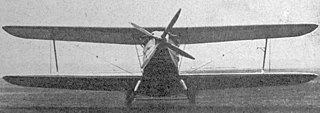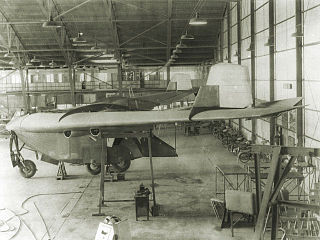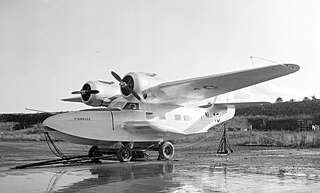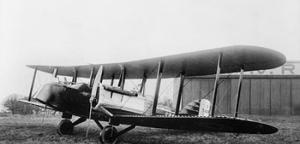Related Research Articles

The Curtiss NC was a flying boat built by Curtiss Aeroplane and Motor Company and used by the United States Navy from 1918 through the early 1920s. Ten of these aircraft were built, the most famous of which is the NC-4, the first airplane to make a transatlantic flight. The NC-4 is preserved in the National Museum of Naval Aviation, at NAS Pensacola, Florida.

The Nord Aviation 3202 was a 1950s French military trainer aircraft designed and built by Nord Aviation to meet a French Army requirement for a two-seat basic trainer, as a replacement for the biplane Stampe SV.4. Altogether, 101 examples were built, with the first flying on 17 April 1957.

The Agusta A.103 was an Italian prototype single-seat light helicopter flown in October 1959. The pilot was enclosed by a perspex bubble with the engine at the rear and the tail rotor carried on an enclosed boom.

The Albatros L 75 Ass was a German trainer biplane of the 1920s. Of conventional configuration, it seated the pilot and instructor in separate, open cockpits. The wings were single-bay, equal-span, and had a slight stagger. Production continued after Albatros was absorbed by Focke-Wulf.
The Beets Special was a single-seat recreational aircraft built in the United States in the mid-1970s with the intention of marketing it for homebuilding. It was a parasol-wing monoplane of conventional configuration with fixed tailwheel undercarriage.

The Savoia-Marchetti SM.62 was an Italian single-engine maritime patrol flying boat produced from 1926. It served with the Regia Aeronautica and with a number of foreign users, and was licence-produced in Spain and the Soviet Union. Some of the Spanish aircraft were still in service during the Spanish Civil War

The Caspar C 35 Priwall was a German airliner of the late 1920s, of which only a single example was built. It was a large, single-engine, single-bay biplane of conventional configuration with fixed tailskid undercarriage. The staggered, equal-span wings were braced with a large I-strut. Not only were the passengers seated within a fully enclosed cabin, but the flight deck was fully enclosed as well.

The DINFIA IA 38 was a 1960s Argentine four-engine experimental tailless transport aircraft, designed under the direction of Reimar Horten and based on the German Horten Ho VIII project and built by the DINFIA.

The Reid Rambler, later known under the Curtiss-Reid brand after Reid was purchased by Curtiss, was a biplane trainer/sport aircraft built in Canada in the early 1930s and used in small numbers as a trainer aircraft by the Royal Canadian Air Force.
The Partenavia P.59 Jolly was an Italian two-seat training monoplane designed by Partenavia to meet a requirement for the Aero Club d'Italia.

The Norsk Flyindustri Finnmark 5A was an amphibious flying-boat airliner built in Norway in the late 1940s. The single prototype was operated by the VLS airline, but no orders for additional aircraft were received, and a refined version designated 5A-II was never built. The Finnmark was a conventional high-wing cantilever monoplane with twin engines housed in nacelles on the wings, and the first twin-engined aircraft constructed in Norway. A specially-designed combination wheel-ski undercarriage retracted into wide sponsons on the sides of the flying boat hull.

PZL M-2 was a Polish trainer aircraft prototype of 1958, a low-wing monoplane with fixed gear. Designed at WSK-Mielec, it did not enter production.

The Avro 533 Manchester was a First World War-era twin-engine biplane photo-reconnaissance and bomber aircraft designed and manufactured by Avro.

The Douglas DF was a commercial flying boat built by Douglas Aircraft Company, first flown on 24 September 1936.

The Naval Aircraft Factory TG were a series of prototype seaplanes for gunnery training designed and built by the United States Navy's Naval Aircraft Factory.

The Hall XP2H-1 was an American prototype four-engined biplane flying boat of the 1930s. Intended as an experimental very-long-range maritime patrol aircraft, a single example was built. The XP2H-1 was the largest four engine biplane aircraft ever procured by the US Navy.

The Sorrell Hiperlight is a family of single and two seat, negative stagger biplanes, designed for amateur construction.

The Sorrell SNS-2 Guppy is an American single-seat, negative stagger, cabin biplane designed for amateur construction that was produced in kit form by the Sorrell Aircraft Company of Tenino, Washington. As of 2019 plans were available from Thunderbird Aviation of Ray, Michigan.
The Hoffman X-1Sweet Patootie is an American homebuilt aircraft designed by Edward C. Hoffman, first flying on 24 February 1960.
The Victa R-2 was a prototype Australian single-engine four-seat light aircraft built by Victa Ltd in the early 1960s. A single example was built, first flying in February 1961, but no production followed.
References
- Taylor, John W. R. (1961). Jane's All The World's Aircraft 1961–62. London: Sampson Low, Marston & Company, Ltd.